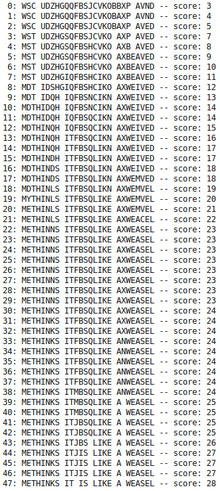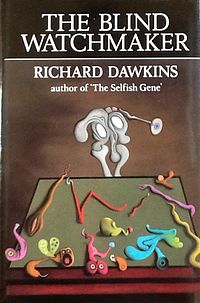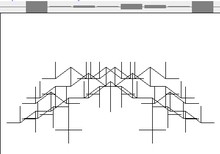https://en.wikipedia.org/wiki/Gene-centered_view_of_evolution
The gene-centered view of evolution, gene's eye view, gene selection theory, or selfish gene theory holds that adaptive evolution occurs through the differential survival of competing genes, increasing the allele frequency of those alleles whose phenotypic trait
effects successfully promote their own propagation, with gene defined
as "not just one single physical bit of DNA [but] all replicas of a
particular bit of DNA distributed throughout the world". The proponents of this viewpoint argue that, since heritable information is passed from generation to generation almost exclusively by DNA, natural selection and evolution are best considered from the perspective of genes.
Proponents of the gene-centered viewpoint argue that it permits understanding of diverse phenomena such as altruism and intragenomic conflict that are otherwise difficult to explain from an organism-centered viewpoint.
The gene-centered view of evolution is a synthesis of the theory of evolution by natural selection, the particulate inheritance theory, and the non-transmission of acquired characters. It states that those alleles whose phenotypic effects successfully promote their own propagation will be favorably selected relative to their competitor alleles within the population. This process produces adaptations for the benefit of alleles that promote the reproductive success of the organism, or of other organisms containing the same allele (kin altruism and green-beard effects), or even its own propagation relative to the other genes within the same organism (selfish genes and intragenomic conflict).
The gene-centered perspective can be traced to the philosopher Henri Bergson who wrote:
Proponents of the gene-centered viewpoint argue that it permits understanding of diverse phenomena such as altruism and intragenomic conflict that are otherwise difficult to explain from an organism-centered viewpoint.
The gene-centered view of evolution is a synthesis of the theory of evolution by natural selection, the particulate inheritance theory, and the non-transmission of acquired characters. It states that those alleles whose phenotypic effects successfully promote their own propagation will be favorably selected relative to their competitor alleles within the population. This process produces adaptations for the benefit of alleles that promote the reproductive success of the organism, or of other organisms containing the same allele (kin altruism and green-beard effects), or even its own propagation relative to the other genes within the same organism (selfish genes and intragenomic conflict).
The gene-centered perspective can be traced to the philosopher Henri Bergson who wrote:
Life is like a current passing from germ to germ through the medium of a developed organism. It is as if the organism itself were only an excrescence, a bud caused to sprout by the former endeavouring to continue itself in a new germ.
— Creative Evolution (1907)
Overview
John Maynard Smith
Richard Dawkins
The gene-centered view of evolution is a model for the evolution of social characteristics such as selfishness and altruism.
Acquired characteristics
The formulation of the central dogma of molecular biology was summarized by Maynard Smith:
If the central dogma is true, and if it is also true that nucleic acids are the only means whereby information is transmitted between generations, this has crucial implications for evolution. It would imply that all evolutionary novelty requires changes in nucleic acids, and that these changes – mutations – are essentially accidental and non-adaptive in nature. Changes elsewhere – in the egg cytoplasm, in materials transmitted through the placenta, in the mother's milk – might alter the development of the child, but, unless the changes were in nucleic acids, they would have no long-term evolutionary effects.
— Maynard Smith
The rejection of the inheritance of acquired characters, combined with Ronald Fisher the statistician, giving the subject a mathematical footing, and showing how Mendelian genetics was compatible with natural selection in his 1930 book The Genetical Theory of Natural Selection. J. B. S. Haldane, and Sewall Wright, paved the way to the formulation of the selfish-gene theory.[clarification needed] For cases where environment can influence heredity, see epigenetics.
The gene as the unit of selection
The view of the gene as the unit of selection was developed mainly in the works of Richard Dawkins, W. D. Hamilton, Colin Pittendrigh and George C. Williams. It was mainly popularized and expanded by Dawkins in his book The Selfish Gene (1976).
According to Williams' 1966 book Adaptation and Natural Selection,
[t]he essence of the genetical theory of natural selection is a statistical bias in the relative rates of survival of alternatives (genes, individuals, etc.). The effectiveness of such bias in producing adaptation is contingent on the maintenance of certain quantitative relationships among the operative factors. One necessary condition is that the selected entity must have a high degree of permanence and a low rate of endogenous change, relative to the degree of bias (differences in selection coefficients).
— Williams, 1966
Williams argued that "[t]he natural selection of phenotypes
cannot in itself produce cumulative change, because phenotypes are
extremely temporary manifestations." Each phenotype is the unique
product of the interaction between genome and environment. It does not
matter how fit and fertile a phenotype is, it will eventually be
destroyed and will never be duplicated.
Since 1954, it has been known that DNA is the main physical substrate to genetic information, and it is capable of high-fidelity replication through many generations. So, a particular gene coded in a nucleobase sequence of a lineage of replicated DNA molecules can have a high permanence and a low rate of endogenous change.
In normal sexual reproduction, an entire genome
is the unique combination of father's and mother's chromosomes produced
at the moment of fertilization. It is generally destroyed with its
organism, because "meiosis and recombination destroy genotypes as surely as death." Only half of it is transmitted to each descendant due to independent segregation.
And the high prevalence of horizontal gene transfer in bacteria and archaea
means that genomic combinations of these asexually reproducing groups
are also transient in evolutionary time: "The traditional view, that
prokaryotic evolution can be understood primarily in terms of clonal
divergence and periodic selection, must be augmented to embrace gene
exchange as a creative force."
The gene as an informational entity persists for an
evolutionarily significant span of time through a lineage of many
physical copies.
In his book River out of Eden, Dawkins coins the phrase God's utility function to explain his view on genes as units of selection. He uses this phrase as a synonym of the "meaning of life" or the "purpose of life". By rephrasing the word purpose in terms of what economists call a utility function, meaning "that which is maximized", Dawkins attempts to reverse-engineer the purpose in the mind of the Divine Engineer of Nature, or the utility function of god. Finally, Dawkins argues that it is a mistake to assume that an ecosystem or a species
as a whole exists for a purpose. He writes that it is incorrect to
suppose that individual organisms lead a meaningful life either; in
nature, only genes have a utility function – to perpetuate their own
existence with indifference to great sufferings inflicted upon the
organisms they build, exploit and discard.
Organisms as vehicles
Genes
are usually packed together inside a genome, which is itself contained
inside an organism. Genes group together into genomes because "genetic
replication makes use of energy and substrates that are supplied by the
metabolic economy in much greater quantities than would be possible
without a genetic division of labour."
They build vehicles to promote their mutual interests of jumping into
the next generation of vehicles. As Dawkins puts it, organisms are the "survival machines" of genes.
The phenotypic effect of a particular gene is contingent on its
environment, including the fellow genes constituting with it the total
genome. A gene never has a fixed effect, so how is it possible to speak
of a gene for long legs? It is because of the phenotypic differences
between alleles. One may say that one allele, all other things being
equal or varying within certain limits, causes greater legs than its
alternative. This difference enables the scrutiny of natural selection.
"A gene can have multiple phenotypic effects, each of which may
be of positive, negative or neutral value. It is the net selective value
of a gene's phenotypic effect that determines the fate of the gene."
For instance, a gene can cause its bearer to have greater reproductive
success at a young age, but also cause a greater likelihood of death at a
later age. If the benefit outweighs the harm, averaged out over the
individuals and environments in which the gene happens to occur, then
phenotypes containing the gene will generally be positively selected and
thus the abundance of that gene in the population will increase.
Even so, it becomes necessary to model the genes in combination
with their vehicle as well as in combination with the vehicle's
environment.
Selfish-gene theory
The selfish-gene theory of natural selection can be restated as follows:
Genes do not present themselves naked to the scrutiny of natural selection, instead they present their phenotypic effects. [...] Differences in genes give rise to differences in these phenotypic effects. Natural selection acts on the phenotypic differences and thereby on genes. Thus genes come to be represented in successive generations in proportion to the selective value of their phenotypic effects.
— Cronin, 1991
The result is that "the prevalent genes in a sexual population must
be those that, as a mean condition, through a large number of genotypes
in a large number of situations, have had the most favourable phenotypic
effects for their own replication." In other words, we expect selfish genes
("selfish" meaning that it promotes its own survival without
necessarily promoting the survival of the organism, group or even
species). This theory implies that adaptations
are the phenotypic effects of genes to maximize their representation in
future generations. An adaptation is maintained by selection if it
promotes genetic survival directly, or else some subordinate goal that
ultimately contributes to successful reproduction.
Individual altruism and genetic egoism
The
gene is a unit of hereditary information that exists in many physical
copies in the world, and which particular physical copy will be
replicated and originate new copies does not matter from the gene's
point of view.
A selfish gene could be favored by selection by producing altruism
among organisms containing it. The idea is summarized as follows:
If a gene copy confers a benefit B on another vehicle at cost C to its own vehicle, its costly action is strategically beneficial if pB > C, where p is the probability that a copy of the gene is present in the vehicle that benefits. Actions with substantial costs therefore require significant values of p. Two kinds of factors ensure high values of p: relatedness (kinship) and recognition (green beards).
— Haig, 1997
A gene in a somatic
cell of an individual may forego replication to promote the
transmission of its copies in the germ line cells. It ensures the high
value of p = 1 due to their constant contact and their common origin from the zygote.
The kin selection
theory predicts that a gene may promote the recognition of kinship by
historical continuity: a mammalian mother learns to identify her own
offspring in the act of giving birth; a male preferentially directs
resources to the offspring of mothers with whom he has copulated; the
other chicks in a nest are siblings; and so on. The expected altruism
between kin is calibrated by the value of p, also known as the coefficient of relatedness. For instance, an individual has a p = 1/2 in relation to his brother, and p = 1/8 to his cousin, so we would expect, ceteris paribus, greater altruism among brothers than among cousins. In this vein, geneticist J. B. S. Haldane famously joked, "Would I lay down my life to save my brother? No, but I would to save two brothers or eight cousins."
However, examining the human propensity for altruism, kin selection
theory seems incapable of explaining cross-familiar, cross-racial and
even cross-species acts of kindness.
Green-beard effect
Green-beard effects gained their name from a thought-experiment of Richard Dawkins,
who considered the possibility of a gene that caused its possessors to
develop a green beard and to be nice to other green-bearded individuals.
Since then, "green-beard effect" has come to refer to forms of genetic
self-recognition in which a gene in one individual might direct benefits
to other individuals that possess the gene. Such genes would be especially selfish,
benefiting themselves regardless of the fates of their vehicles. After
Dawkins predicted them, green-beard genes have been discovered in
nature, such as Gp-9 in fire ants (Solenopsis invicta), csA in social amoeba (Dictyostelium discoideum), and FLO1 in budding yeast (Saccharomyces cerevisiae).
Intragenomic conflict
As genes are capable of producing individual altruism, they are
capable of producing conflict among genes inside the genome of one
individual. This phenomenon is called intragenomic conflict
and arises when one gene promotes its own replication in detriment to
other genes in the genome. The classic example is segregation distorter
genes that cheat during meiosis or gametogenesis and end up in more than half of the functional gametes. These genes can persist in a population even when their transmission results in reduced fertility.
Egbert Leigh compared the genome to "a parliament of genes: each acts
in its own self-interest, but if its acts hurt the others, they will
combine together to suppress it" to explain the relative low occurrence
of intragenomic conflict.
Price equation
The Price equation is a covariance equation that is a mathematical description of evolution and natural selection. The Price equation was derived by George R. Price, working in London to rederive W. D. Hamilton's work on kin selection.
Advocates
Besides Richard Dawkins and George C. Williams, other biologists and philosophers have expanded and refined the selfish-gene theory, such as John Maynard Smith, George R. Price, Robert Trivers, David Haig, Helena Cronin, David Hull, Philip Kitcher, and Daniel C. Dennett.
Criticisms
The gene-centric view has been opposed by Ernst Mayr, Stephen Jay Gould, David Sloan Wilson, and philosopher Elliott Sober. An alternative, multilevel selection (MLS), has been advocated by E. O. Wilson, David Sloan Wilson, Sober, Richard E. Michod, and Samir Okasha.
Writing in the New York Review of Books, Gould has characterized the gene-centered perspective as confusing book-keeping with causality.
Gould views selection as working on many levels, and has called
attention to a hierarchical perspective of selection. Gould also called
the claims of Selfish Gene "strict adaptationism", "ultra-Darwinism", and "Darwinian fundamentalism", describing them as excessively "reductionist". He saw the theory as leading to a simplistic "algorithmic" theory of evolution, or even to the re-introduction of a teleological principle. Mayr went so far as to say "Dawkins' basic theory of the gene being the object of evolution is totally non-Darwinian."
Gould also addressed the issue of selfish genes in his essay "Caring groups and selfish genes".
Gould acknowledged that Dawkins was not imputing conscious action to
genes, but simply using a shorthand metaphor commonly found in
evolutionary writings. To Gould, the fatal flaw was that "no matter how
much power Dawkins wishes to assign to genes, there is one thing that he
cannot give them – direct visibility to natural selection."
Rather, the unit of selection is the phenotype, not the genotype,
because it is phenotypes that interact with the environment at the
natural-selection interface. So, in Kim Sterelny's summation of Gould's view, "gene differences do not cause evolutionary changes in populations, they register those changes." Richard Dawkins replied to this criticism in a later book, The Extended Phenotype,
that Gould confused particulate genetics with particulate embryology,
stating that genes do "blend", as far as their effects on developing
phenotypes are concerned, but that they do not blend as they replicate
and recombine down the generations.
Since Gould's death in 2002, Niles Eldredge has continued with counter-arguments to gene-centered natural selection. Eldredge notes that in Dawkins' book A Devil's Chaplain,
which was published just before Eldredge's book, "Richard Dawkins
comments on what he sees as the main difference between his position and
that of the late Stephen Jay Gould. He concludes that it is his own
vision that genes play a causal role in evolution," while Gould (and
Eldredge) "sees genes as passive recorders of what worked better than
what."










